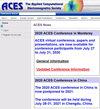Ultra-wideband Flexible Implantable Antenna for Wireless Capsule Endoscopy System with Performance Improvement
IF 0.6
4区 计算机科学
Q4 ENGINEERING, ELECTRICAL & ELECTRONIC
Applied Computational Electromagnetics Society Journal
Pub Date : 2021-01-01
DOI:10.47037/2020.aces.j.360618
引用次数: 0
Abstract
The implantable antenna is an important part of the wireless capsule endoscopy (WCE) system to achieve wireless communication. This paper designed an ultra-wideband flexible implantable antenna for wireless capsule endoscopy system. With a very wide bandwidth, the antenna can completely cover the industrial, scientific, and medical frequency bands (ISM, 2.4-2.48 GHz) and Wireless Medical Telemetry Service (WMTS, 1.395-1.4 GHz). The expanded size of the proposed antenna is 18mm× 10mm× 0.1mm. The conformal technology of the antenna has further reduced the space of the system and achieved miniaturization. The capsule antenna in this paper is a compact planar monopole antenna fed by a coplanar waveguide, and it uses a flexible material as a dielectric substrate to achieve the conformal shape of the antenna. U-shaped ground branch (UGB) and a loaded split ring resonator (SRR) structure were used to further improve the antenna performance. Simulation and measurement results were basically the same. On the premise of radiation safety and miniaturization of the antenna, the ultra-wideband operation of the antenna was realized. This antenna design provided reference value for the design and application of the capsule antenna.改进无线胶囊内窥镜系统的超宽带柔性植入式天线
植入式天线是无线胶囊内窥镜(WCE)系统实现无线通信的重要组成部分。设计了一种用于无线胶囊内窥镜系统的超宽带柔性植入式天线。该天线具有非常宽的带宽,可以完全覆盖工业、科学和医疗频段(ISM, 2.4-2.48 GHz)和无线医疗遥测服务(WMTS, 1.395-1.4 GHz)。天线的扩展尺寸为18mm× 10mm× 0.1mm。天线的保形技术进一步缩小了系统的空间,实现了小型化。本文的胶囊天线是一种紧凑的平面单极天线,采用共面波导馈电,采用柔性材料作为电介质衬底,实现了天线的共形。采用u型接地支路(UGB)和负载分环谐振器(SRR)结构,进一步提高了天线性能。仿真结果与实测结果基本一致。在保证天线辐射安全和小型化的前提下,实现了天线的超宽带工作。该天线设计为胶囊天线的设计和应用提供了参考价值。
本文章由计算机程序翻译,如有差异,请以英文原文为准。
求助全文
约1分钟内获得全文
求助全文
来源期刊
CiteScore
1.60
自引率
28.60%
发文量
75
审稿时长
9 months
期刊介绍:
The ACES Journal is devoted to the exchange of information in computational electromagnetics, to the advancement of the state of the art, and to the promotion of related technical activities. A primary objective of the information exchange is the elimination of the need to "re-invent the wheel" to solve a previously solved computational problem in electrical engineering, physics, or related fields of study.
The ACES Journal welcomes original, previously unpublished papers, relating to applied computational electromagnetics. All papers are refereed.
A unique feature of ACES Journal is the publication of unsuccessful efforts in applied computational electromagnetics. Publication of such material provides a means to discuss problem areas in electromagnetic modeling. Manuscripts representing an unsuccessful application or negative result in computational electromagnetics is considered for publication only if a reasonable expectation of success (and a reasonable effort) are reflected.
The technical activities promoted by this publication include code validation, performance analysis, and input/output standardization; code or technique optimization and error minimization; innovations in solution technique or in data input/output; identification of new applications for electromagnetics modeling codes and techniques; integration of computational electromagnetics techniques with new computer architectures; and correlation of computational parameters with physical mechanisms.

 求助内容:
求助内容: 应助结果提醒方式:
应助结果提醒方式:


